warning Seat Exeo ST 2010 Owner's manual
[x] Cancel search | Manufacturer: SEAT, Model Year: 2010, Model line: Exeo ST, Model: Seat Exeo ST 2010Pages: 325, PDF Size: 9.34 MB
Page 156 of 325
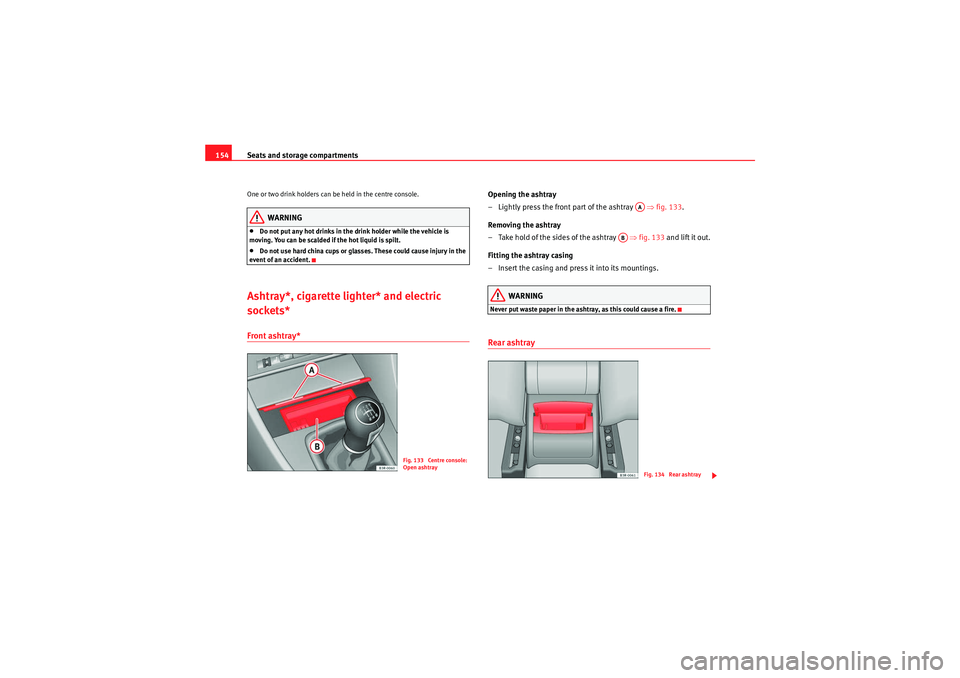
Seats and storage compartments
154One or two drink holders can be held in the centre console.
WARNING
•Do not put any hot drinks in the drink holder while the vehicle is
moving. You can be scalded if the hot liquid is spilt.•Do not use hard china cups or glasses. These could cause injury in the
event of an accident.
Ashtray*, cigarette lighter* and electric
sockets*Front ashtray*
Opening the ashtray
– Lightly press the front part of the ashtray ⇒fig. 133 .
Removing the ashtray
– Take hold of the sides of the ashtray ⇒ fig. 133 and lift it out.
Fitting the ashtray casing
– Insert the casing and press it into its mountings.
WARNING
Never put waste paper in the ashtray, as this could cause a fire.Rear ashtray
Fig. 133 Centre console:
Open ashtray
AA
AB
Fig. 134 Rear ashtray
ExeoST_EN.book Seite 154 Freitag, 3. September 2010 11:41 11
Page 157 of 325

Seats and storage compartments155
Safety First
Operating Instructions
Practical Tips
Technical Specifications
Opening the ashtray
– Lift the lid.
Removing the ashtray
– Take hold of the lid ⇒page 154, fig. 134 and lift out the ashtray.
Fitting the ashtray casing
– Open the lid on the ashtray and press the casing into the mounting as far as it will go.
WARNING
Never put waste paper in the ashtray, as this could cause a fire.
Cigarette lighter*
The 12 volt socket for the cigarette lighter can also be used as
a power source for other electrical appliances.Using the cigarette lighter
–Press in the ciga rette lighter button.
– Wait for the lighter to pop out slightly.
– Pull out the cigarette lighter immediately.
– Use the glowing heater element of the cigarette lighter to light your cigarette.
– Put the cigarette lighter back in its socket.
Operating the socket
– Take out the cigarette lighter.
Fig. 135 Cigarette lighter
in the centre console
ExeoST_EN.book Seite 155 Freitag, 3. September 2010 11:41 11
Page 158 of 325
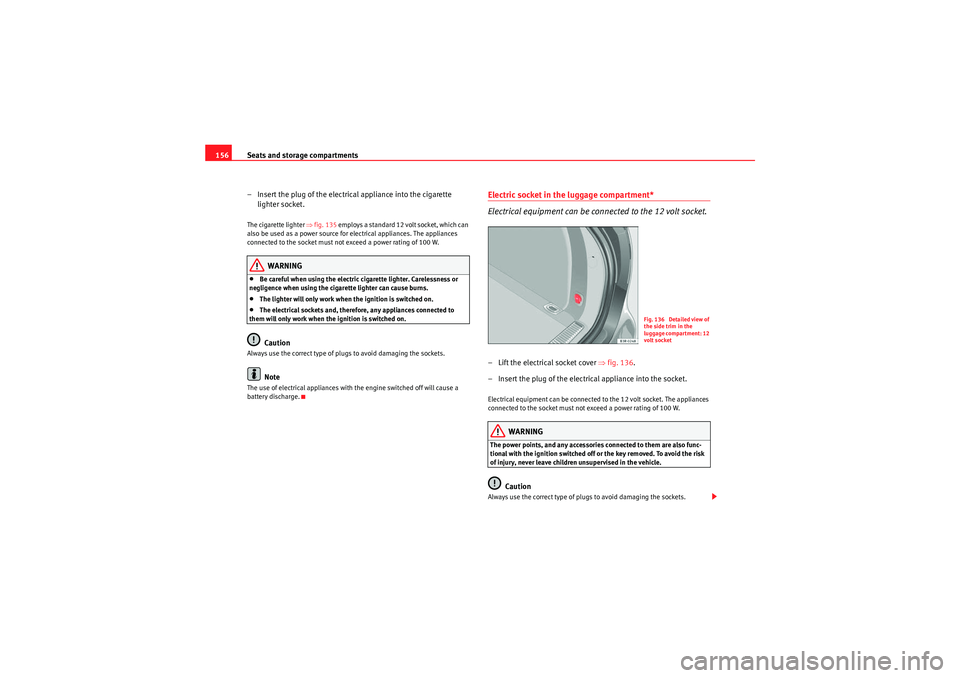
Seats and storage compartments
156
– Insert the plug of the electrical appliance into the cigarette lighter socket.The cigarette lighter ⇒fig. 135 e m ploys a standa rd 12 volt so cket , wh ich can
also be used as a power source for electrical appliances. The appliances
connected to the socket must not exceed a power rating of 100 W.
WARNING
•Be careful when using the electric cigarette lighter. Carelessness or
negligence when using the cigarette lighter can cause burns.•The lighter will only work when the ignition is switched on.•The electrical sockets and, therefore, any appliances connected to
them will only work when the ignition is switched on.Caution
Always use the correct type of plugs to avoid damaging the sockets.
Note
The use of electrical appliances with the engine switched off will cause a
battery discharge.
Electric socket in the luggage compartment*
Electrical equipment can be connected to the 12 volt socket.– Lift the electrical socket cover ⇒ fig. 136.
– Insert the plug of the electrical appliance into the socket.Electrical equipment can be connected to the 12 volt socket. The appliances
connected to the socket must not exceed a power rating of 100 W.
WARNING
The power points, and any accessories connected to them are also func-
tional with the ignition switched off or the key removed. To avoid the risk
of injury, never leave children unsupervised in the vehicle.
Caution
Always use the correct type of plugs to avoid damaging the sockets.
Fig. 136 Detailed view of
the side trim in the
luggage compartment: 12
volt socket
ExeoST_EN.book Seite 156 Freitag, 3. September 2010 11:41 11
Page 159 of 325
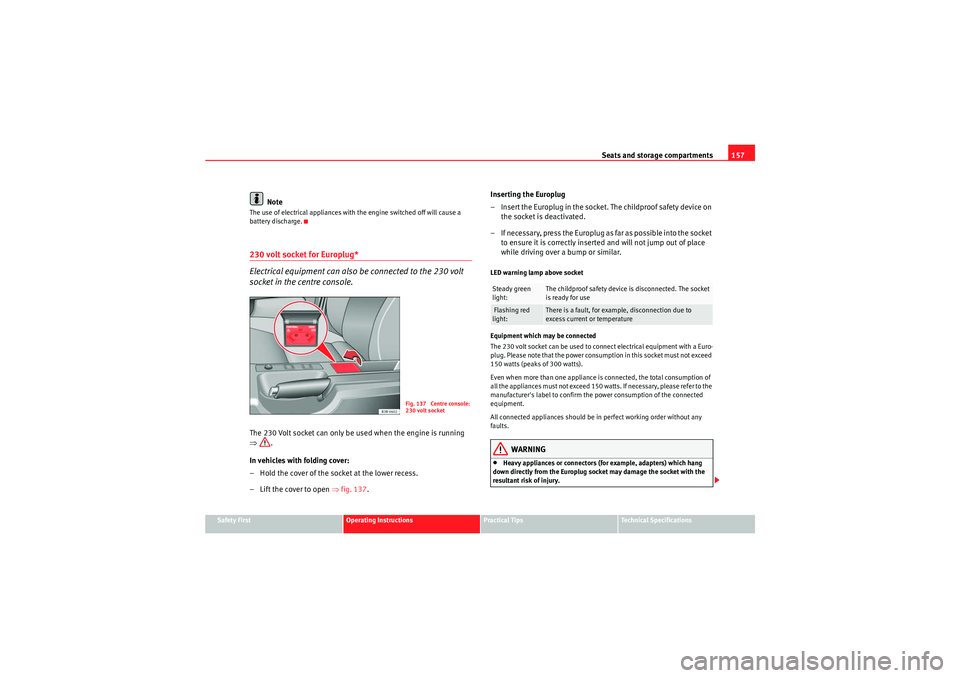
Seats and storage compartments157
Safety First
Operating Instructions
Practical Tips
Technical Specifications
Note
The use of electrical appliances with the engine switched off will cause a
battery discharge.230 volt socket for Europlug*
Electrical equipment can also be connected to the 230 volt
socket in the centre console.The 230 Volt socket can only be used when the engine is running
⇒.
In vehicles with folding cover:
– Hold the cover of the socket at the lower recess.
– Lift the cover to open ⇒ fig. 137. Inserting the Europlug
– Insert the Europlug in the socket. The childproof safety device on
the socket is deactivated.
– If necessary, press the Europlug as far as possible into the socket
to ensure it is correctly inserted and will not jump out of place
while driving over a bump or similar.
LED warning lamp above socket
Equipment which may be connected
The 230 volt socket can be used to connect electrical equipment with a Euro-
plug. Please note that the power consumption in this socket must not exceed
150 watts (peaks of 300 watts).
Even when more than one appliance is connected, the total consumption of
all the appliances must not exceed 150 watts. If necessary, please refer to the
manufacturer's label to confirm the power consumption of the connected
equipment.
All connected appliances should be in perfect working order without any
faults.
WARNING
•Heavy appliances or connectors (for example, adapters) which hang
down directly from the Europlug socket may damage the socket with the
resultant risk of injury.
Fig. 137 Centre console:
230 volt socket
Steady green
light:
The childproof safety device is disconnected. The socket
is ready for use
Flashing red
light:
There is a fault, for example, disconnection due to
excess current or temperature
ExeoST_EN.book Seite 157 Freitag, 3. September 2010 11:41 11
Page 160 of 325
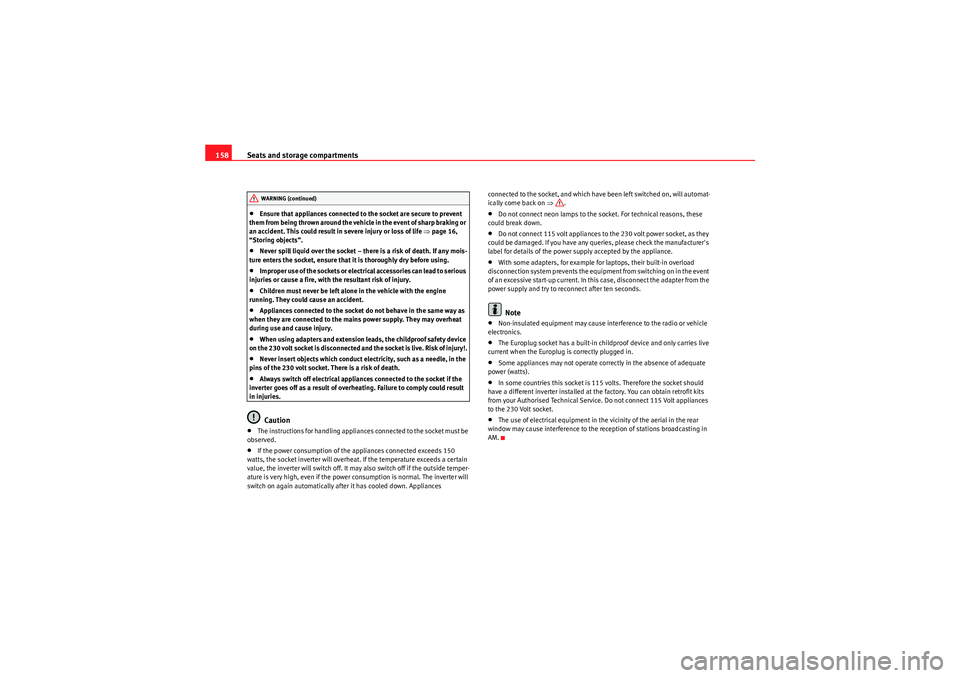
Seats and storage compartments
158•Ensure that appliances connected to the socket are secure to prevent
them from being thrown around the vehicle in the event of sharp braking or
an accident. This could result in severe injury or loss of life ⇒page 16,
“Storing objects”.•Never spill liquid over the socket – there is a risk of death. If any mois-
ture enters the socket, ensure that it is thoroughly dry before using.•Improper use of the sockets or electrical accessories can lead to serious
injuries or cause a fire, with the resultant risk of injury.•Children must never be left alone in the vehicle with the engine
running. They could cause an accident.•Appliances connected to the socket do not behave in the same way as
when they are connected to the mains power supply. They may overheat
during use and cause injury.•When using adapters and extension leads, the childproof safety device
on the 230 volt socket is disconnected and the socket is live. Risk of injury!.•Never insert objects which conduct electricity, such as a needle, in the
pins of the 230 volt socket. There is a risk of death.•Always switch off electrical appliances connected to the socket if the
inverter goes off as a result of overheating. Failure to comply could result
in injuries.Caution
•The instructions for handling appliances connected to the socket must be
observed.•If the power consumption of the appliances connected exceeds 150
watts, the socket inverter will overheat. If the temperature exceeds a certain
value, the inverter will switch off. It may also switch off if the outside temper-
ature is very high, even if the power consumption is normal. The inverter will
switch on again automatically after it has cooled down. Appliances connected to the socket, and which have been left switched on, will automat-
ically come back on
⇒.
•Do not connect neon lamps to the socket. For technical reasons, these
could break down.•Do not connect 115 volt appliances to the 230 volt power socket, as they
could be damaged. If you have any queries, please check the manufacturer's
label for details of the power supply accepted by the appliance.•With some adapters, for example for laptops, their built-in overload
disconnection system prevents the equipment from switching on in the event
of an excessive star t-up current. In this case, disconnect the adapter from the
power supply and try to reconnect after ten seconds.Note
•Non-insulated equipment may cause interference to the radio or vehicle
electronics.•The Europlug socket has a built-in childproof device and only carries live
current when the Europlug is correctly plugged in.•Some appliances may not operate correctly in the absence of adequate
power (watts).•In some countries this socket is 115 volts. Therefore the socket should
have a different inverter installed at the factory. You can obtain retrofit kits
from your Authorised Technical Service. Do not connect 115 Volt appliances
to the 230 Volt socket.•The use of electrical equipment in the vicinity of the aerial in the rear
window may cause interference to the reception of stations broadcasting in
AM.
WARNING (continued)
ExeoST_EN.book Seite 158 Freitag, 3. September 2010 11:41 11
Page 162 of 325
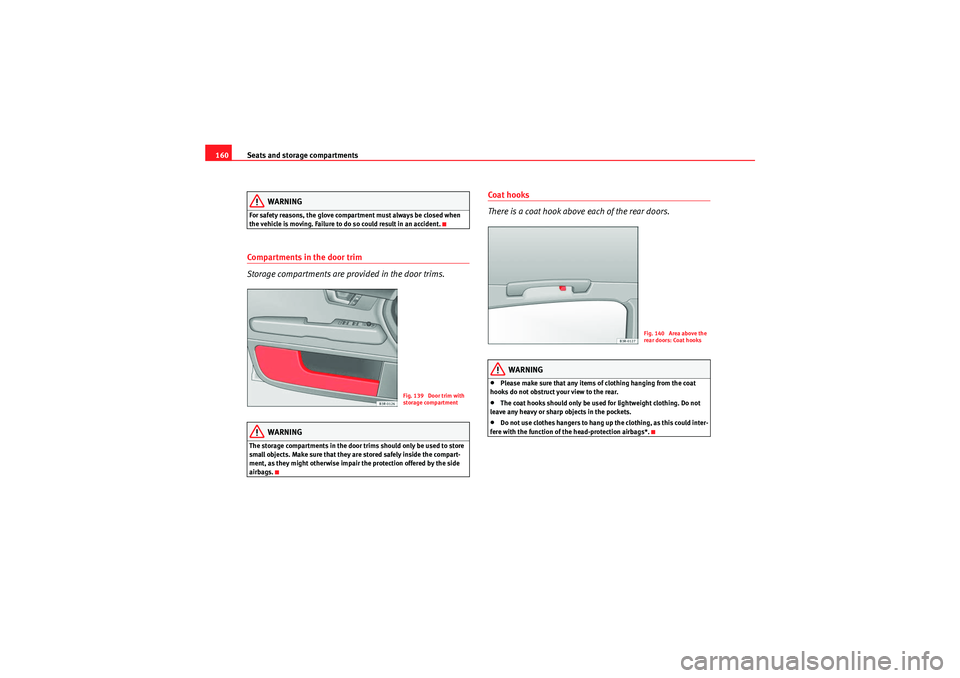
Seats and storage compartments
160
WARNING
For safety reasons, the glove compartment must always be closed when
the vehicle is moving. Failure to do so could result in an accident.Compartments in the door trim
Storage compartments are provided in the door trims.
WARNING
The storage compartments in the door trims should only be used to store
small objects. Make sure that they are stored safely inside the compart-
ment, as they might otherwise impair the protection offered by the side
airbags.
Coat hooks
There is a coat hook above each of the rear doors.
WARNING
•Please make sure that any items of clothing hanging from the coat
hooks do not obstruct your view to the rear.•The coat hooks should only be used for lightweight clothing. Do not
leave any heavy or sharp objects in the pockets.•Do not use clothes hangers to hang up the clothing, as this could inter-
fere with the function of the head-protection airbags*.
Fig. 139 Door trim with
storage compartment
Fig. 140 Area above the
rear doors: Coat hooks
ExeoST_EN.book Seite 160 Freitag, 3. September 2010 11:41 11
Page 168 of 325
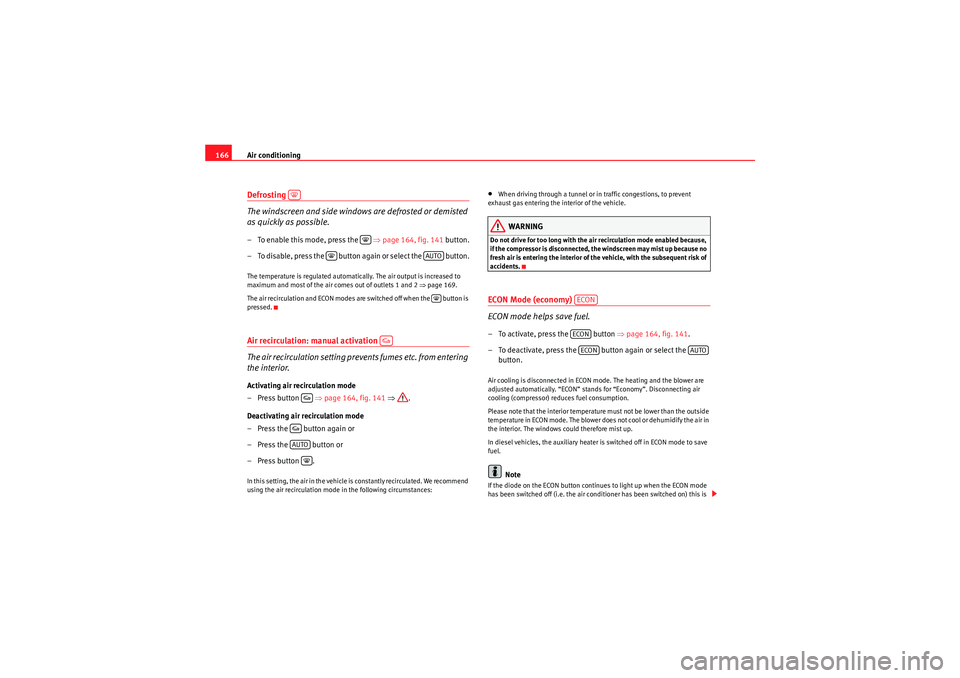
Air conditioning
166Defrosting
The windscreen and side windows are defrosted or demisted
as quickly as possible.– To enable this mode, press the ⇒page 164, fig. 141 button.
– To disable, press the button again or select the button.The temperature is regulated automatically. The air output is increased to
maximum and most of the air comes out of outlets 1 and 2 ⇒page 169.
The air recirculation and ECON modes are switched off when the button is
pressed.Air recirculation: manual activation
The air recirculation setting prevents fumes etc. from entering
the interior.Activating air recirculation mode
–Press button ⇒page 164, fig. 141 ⇒ .
Deactivating air recirculation mode
– Press the button again or
– Press the button or
–Press button .In this setting, the air in the vehicle is constantly recirculated. We recommend
using the air recirculation mode in the following circumstances:
•When driving through a tunnel or in traffic congestions, to prevent
exhaust gas entering the interior of the vehicle.WARNING
Do not drive for too long with the air recirculation mode enabled because,
if the compressor is disconnected, the windscreen may mist up because no
fresh air is entering the interior of the vehicle, with the subsequent risk of
accidents.ECON Mode (economy)
ECON mode helps save fuel.– To activate, press the button ⇒page 164, fig. 141 .
– To deactivate, press the button again or select the button.Air cooling is disconnected in ECON mode. The heating and the blower are
adjusted automatically. “ECON” stands for “Economy”. Disconnecting air
cooling (compressor) reduces fuel consumption.
Please note that the interior temperature must not be lower than the outside
temperature in ECON mode. The blower does not cool or dehumidify the air in
the interior. The windows could therefore mist up.
In diesel vehicles, the auxiliary heater is switched off in ECON mode to save
fuel.
Note
If the diode on the ECON button continues to light up when the ECON mode
has been switched off (i.e. the air conditioner has been switched on) this is
�<
�<
�<
AUTO�<
AUTO�<
ECONECONECON
AUTO
ExeoST_EN.book Seite 166 Freitag, 3. September 2010 11:41 11
Page 174 of 325

Driving
172DrivingSteeringAdjusting the steering wheel position
The height and reach of the steering wheel can be freely
adjusted to suit the driver–Push the lever ⇒ fig. 145 down ⇒.
– Move the steering wheel to the desired position.
– Then push the lever back up against the steering column until it engages in position.
WARNING
•Never adjust the position of the steering wheel when the vehicle is
moving, as this could cause an accident.•For safety reasons, the lever must always be securely engaged when
the vehicle is moving, so that the position of the steering wheel cannot
shift unexpectedly. Otherwise this could cause an accident.
SafetyElectronic Stability Programme (ESP)
ESP helps make driving safer in certain situations.
Fig. 145 Lever beneath
steering column
Fig. 146 Detailed view of
the centre console: ESP
button
ExeoST_EN.book Seite 172 Freitag, 3. September 2010 11:41 11
Page 175 of 325

Driving173
Safety First
Operating Instructions
Practical Tips
Technical Specifications
The Electronic Stability Programme (ESP) contains the electronic differential
lock (EDL) and the traction control system (TCS). The ESP function works
together with the ABS. If a fault in the ABS occurs, both warning lamps light
up, but if the ESP fails, only the ESP warning lamp lights up.
The ESP is started automatically when the engine is started.
The ESP switch deactivates both TCS and ESP functions. The ESP, in spite of
being deactivated, will always self-connect when necessary if brakes are
being used.
The TCS can be deactivated when in cases where wheel sliding is desirable.
For example:
•When driving with snow chains,•when driving in deep snow or on loose surfaces,•when rocking the vehicle backwards and forwards to free it from mud, for
example.
Next, the button should be pressed to reactivate the TCS.
When does the warning lamp switch on or flash?•On switching the ignition on, it lights up for about two seconds to carry
out a function control.•The warning lamp will start flashing when the vehicle is moving if the ESP
or the TCS is activated.•It will light up continuously if there is a malfunction in the ESP.WARNING
•The Electronic Stability Programme (ESP) cannot defy the laws of
physics. This should be kept in mind, particularly on slippery and wet
roads and when towing a trailer.•Always adapt your driving style to suit the condition of the roads and
the traffic situation. Do not let the extra safety afforded by ESP tempt you
into taking any risks when driving, as this can cause accidents.
•Please refer to the corresponding warning notes on ESP in ⇒page 191,
“Intelligent technology”.
Ignition lockIgnition key positions
The ignition key is used to start and stop the engine.Position
The ignition key is inserted in this position. To engage the steering wheel
lock , take out the key and turn the wheel until you hear the pin engage. You
should always engage the steering lock when you leave the vehicle. This will
help to deter thefts ⇒.
WARNING (continued)
Fig. 147 Ignition key
positions
A1
ExeoST_EN.book Seite 173 Freitag, 3. September 2010 11:41 11
Page 176 of 325
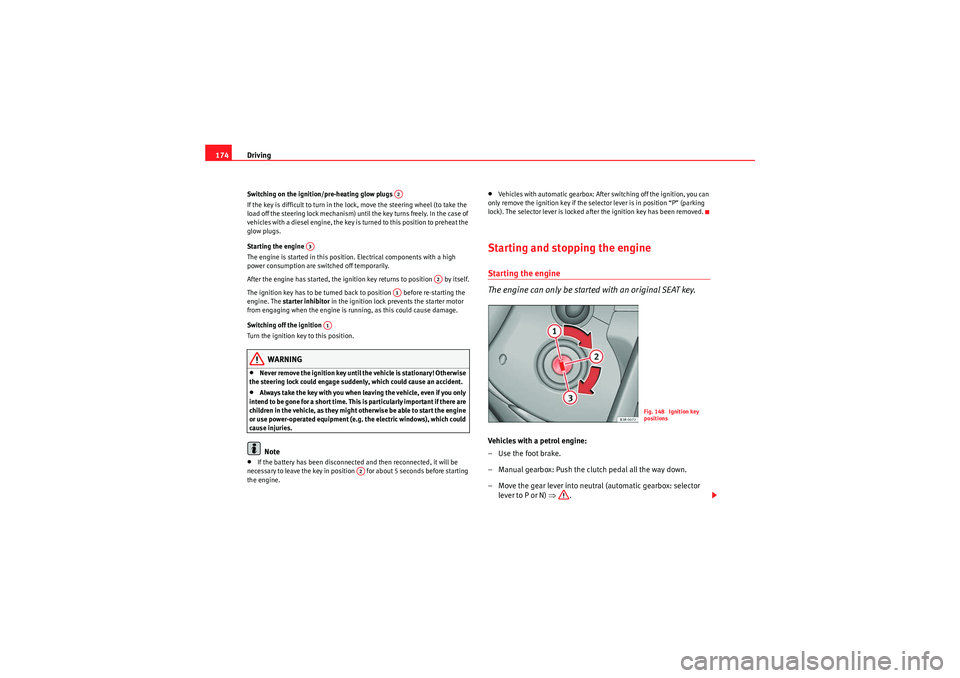
Driving
174Switching on the ignition/pre-heating glow plugs
If the key is difficult to turn in the lock, move the steering wheel (to take the
load off the steering lock mechanism) until the key turns freely. In the case of
vehicles with a diesel engine, the key is turned to this position to preheat the
glow plugs.
Starting the engine
The engine is started in this position. Electrical components with a high
power consumption are switched off temporarily.
After the engine has started, the ignition key returns to position by itself.
The ignition key has to be turned back to position before re-starting the
engine. The starter inhibitor in the ignition lock prevents the starter motor
from engaging when the engine is running, as this could cause damage.
Switching off the ignition
Turn the ignition key to this position.
WARNING
•Never remove the ignition key until the vehicle is stationary! Otherwise
the steering lock could engage suddenly, which could cause an accident.•Always take the key with you when leaving the vehicle, even if you only
intend to be gone for a short time. This is particularly important if there are
children in the vehicle, as they might otherwise be able to start the engine
or use power-operated equipment (e.g. the electric windows), which could
cause injuries.Note
•If the battery has been disconnected and then reconnected, it will be
necessary to leave the key in position for about 5 seconds before starting
the engine.
•Vehicles with automatic gearbox: After switching off the ignition, you can
only remove the ignition key if the selector lever is in position “P” (parking
lock). The selector lever is locked after the ignition key has been removed.Starting and stopping the engineStarting the engine
The engine can only be started with an original SEAT key.Vehicles with a petrol engine:
– Use the foot brake.
– Manual gearbox: Push the clutch pedal all the way down.
– Move the gear lever into neutral (automatic gearbox: selector lever to P or N) ⇒.
A2
A3
A2
A1
A1
A2
Fig. 148 Ignition key
positions
ExeoST_EN.book Seite 174 Freitag, 3. September 2010 11:41 11